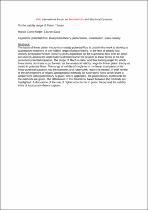JavaScript is disabled for your browser. Some features of this site may not work without it.
- ResearchSpace
- →
- Research Publications/Outputs
- →
- Conference Publications
- →
- View Item
| dc.contributor.author |
Meijer, M-C

|
|
| dc.contributor.author |
Dala, L

|
|
| dc.date.accessioned | 2016-08-22T11:34:54Z | |
| dc.date.available | 2016-08-22T11:34:54Z | |
| dc.date.issued | 2015-06 | |
| dc.identifier.citation | Meijer, MC and Dala, L. 2015. On the validity range of piston theory. In: 16th International Forum on Aeroelasticity and Structural Dynamics, 28 June - 2 July 2015, St. Petersburg, Russia | en_US |
| dc.identifier.uri | Non available | |
| dc.identifier.uri | http://hdl.handle.net/10204/8731 | |
| dc.description | 16th International Forum on Aeroelasticity and Structural Dynamics, 28 June-2 July 2015, St. Petersburg, Russia. Due to copyright restrictions, the attached PDF file only contains the abstract of the full text item. For access to the full text item, please consult the publisher's website. | en_US |
| dc.description.abstract | The basis of linear piston theory in unsteady potential flow is used in this work to develop a quantitative treatment of the validity range of piston theory. In the limit of steady flow, velocity perturbations from Donov’s series expansion for the supersonic flow over an airfoil are used to assess the contributions of nonlinear terms relative to linear terms in the full perturbed potential equation. The range of Mach number and flow turning angle for which linear terms dominate is put forward as the analytical validity range for linear piston theory as based in potential flows. The range of validity of single-term nonlinear extensions to the linear potential equation into the transonic and hypersonic regions is treated. A brief review of the development of related aerodynamic methods for supersonic flows which share a similar form with piston theory is given; where applicable, the piston theory coefficients for the methods are given. The differences in the theoretical bases between the methods are highlighted. A discussion of the role of higher-order terms in piston theory and the validity limits of local piston theory is given. | en_US |
| dc.language.iso | en | en_US |
| dc.publisher | International Forum on Aeroelasticity and Structural Dynamics (IFASD) | en_US |
| dc.relation.ispartofseries | Worklist;15338 | |
| dc.subject | Potential flow | en_US |
| dc.subject | Local piston theory | en_US |
| dc.subject | Perturbation | en_US |
| dc.subject | Linearization | en_US |
| dc.subject | Quasi-steady | en_US |
| dc.title | On the validity range of piston theory | en_US |
| dc.type | Conference Presentation | en_US |
| dc.identifier.apacitation | Meijer, M., & Dala, L. (2015). On the validity range of piston theory. International Forum on Aeroelasticity and Structural Dynamics (IFASD). http://hdl.handle.net/10204/8731 | en_ZA |
| dc.identifier.chicagocitation | Meijer, M-C, and L Dala. "On the validity range of piston theory." (2015): http://hdl.handle.net/10204/8731 | en_ZA |
| dc.identifier.vancouvercitation | Meijer M, Dala L, On the validity range of piston theory; International Forum on Aeroelasticity and Structural Dynamics (IFASD); 2015. http://hdl.handle.net/10204/8731 . | en_ZA |
| dc.identifier.ris | TY - Conference Presentation AU - Meijer, M-C AU - Dala, L AB - The basis of linear piston theory in unsteady potential flow is used in this work to develop a quantitative treatment of the validity range of piston theory. In the limit of steady flow, velocity perturbations from Donov’s series expansion for the supersonic flow over an airfoil are used to assess the contributions of nonlinear terms relative to linear terms in the full perturbed potential equation. The range of Mach number and flow turning angle for which linear terms dominate is put forward as the analytical validity range for linear piston theory as based in potential flows. The range of validity of single-term nonlinear extensions to the linear potential equation into the transonic and hypersonic regions is treated. A brief review of the development of related aerodynamic methods for supersonic flows which share a similar form with piston theory is given; where applicable, the piston theory coefficients for the methods are given. The differences in the theoretical bases between the methods are highlighted. A discussion of the role of higher-order terms in piston theory and the validity limits of local piston theory is given. DA - 2015-06 DB - ResearchSpace DP - CSIR KW - Potential flow KW - Local piston theory KW - Perturbation KW - Linearization KW - Quasi-steady LK - https://researchspace.csir.co.za PY - 2015 T1 - On the validity range of piston theory TI - On the validity range of piston theory UR - http://hdl.handle.net/10204/8731 ER - | en_ZA |






